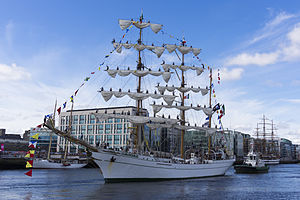

 Cuauhtémoc, 26 August 2012 | |
| History | |
|---|---|
| Name | Cuauhtémoc |
| Builder | Astilleros Celaya S.A., Bilbao, Spain |
| Launched | January 9, 1982 |
| Commissioned | July 29, 1982 |
| Homeport | Acapulco, Mexico |
| Identification | |
| Status | in active service |
| Badge |
|
| General characteristics | |
| Class and type | Steel-hulled sail training vessel |
| Displacement | 1,800 tons |
| Length | 220 ft 4 in (67.16 m) waterline |
| Beam | 39 ft 4 in (11.99 m) |
| Draft | 17.7 ft (5.4 m) |
| Installed power | 1,125 hp (839 kW) Auxiliary engine |
| Sail plan |
|
| Capacity |
|
| Crew |
|
ARM Cuauhtémoc is a sail training vessel of the Mexican Navy, named for the last Mexica Hueyi Tlatoani Cuauhtémoc who was captured and executed in 1525.
She is the last of four sister ships built by the naval shipyards of Bilbao, Spain, in 1982, all built to a design similar to the 1930 designs of the German firm Blohm & Voss, like Gorch Fock, USCGC Eagle and the NRP Sagres.
Built at the Celaya Shipyards in Bilbao, she was designed by Naval Engineer Juan José Alonso Verástegui. Her keel was laid on July 24, 1981, and she was delivered to the Mexican Navy in Bilbao on July 29, 1982.
Her first commander was Captain Manuel Zermeño del Peón, in command of a crew of cadets from the Mexican Naval Academy who received the ship and brought Cuauhtémoc home to Mexico.[1]
Like her sister ships, Colombia's Gloria, Ecuador's Guayas and Venezuela's Simón Bolívar, Cuauhtémoc is a sailing ambassador for her home country and a frequent visitor to world ports, having sailed over 400,000 nautical miles (700,000 km) in her 38 years of service, with appearances at the Cutty Sark Tall Ships' Races, ASTA Tall Ships Challenges, Sail Osaka, and others.[2]
The body of the shield is made up of two concentric circles: the exterior, like a cord of abaca, suggests the ship's rigging, the tool necessary for the crew to raise and lower the sails. The inner circle serves to concentrically divide the total circumference of the body.
The internal part of these carries in its center the silhouette of Cuauhtémoc on its port side and with all the rigging, sailing to the west, driven by the wind, represents her first trip to Mexico from Spain.
In the ring formed by the two circles there are two inscriptions: reading Armada de México (Mexican Navy) on the top, and Buque Escuela Cuauhtémoc (Cuauhtémoc School Ship), on the bottom.
The same ring offers, at the eastern point, the figure of the wind god Ehécatl, who with his breath propels the ship to the west. At the setting point appears the Sun of the evening twilight; at the north point, interspersed in the inscription, the sidereal stars that make constant knowledge of their position possible. Finally, in the upper part of the body, the eagle of the Mexican Coat of Arms, which recalls the origin of the ship and its strength.[3]
• Atlantic Cruise 1982
• Oriente Cruise 1983
• Tahiti Cruise 1984
• North Atlantic Cruise 1985
• Liberty Cruise 1986
• South Pacific Cruise 1987
• Mediterranean Cruise 1988
• Eurocaribe Cruise 1989
• 1990 Circumnavigation Cruise
• 50th Anniversary Cruise of the Secretary of the Atlantic Navy 1992
• Cape Horn Cruise 1992-1993
• Cruise Europe 1994
• Canada Cruise 1994
• Baltic Cruise 1996
• Cruiser Osaka 1997
• Cruise Australia 1998
• Lisbon Cruise 1998
• 1999 North Sea Cruise
• Euroamerica 2000 Cruise
• Europe Cruise 2001
• 2002 Circumnavigation Cruise
• Rouen Cruise 2003
• Sail Rhode Island 2004
• 2005 North Pacific Training Cruise
• Circumnavigation Cruise 2006
• Baltic Instructional Cruise 2007
• Rouen Cruise 2008
• Japan Instructional Cruise 2009
• 2010 Bicentennial Sailing Instruction Cruise South America
• Mediterranean Cruise 2011
• Atlantic Cruise 2012
• Europe Cruise 2013
• Sail Latin America 2014
• Levante Mediterranean Cruise 2015
• Ibero Atlantic Cruise 2016
• Centennial Cruise of the 2017 Constitution
• Sail Latin America 2018
|
| |||||||||||||||||||||||||||||
|---|---|---|---|---|---|---|---|---|---|---|---|---|---|---|---|---|---|---|---|---|---|---|---|---|---|---|---|---|---|
| Frigates |
| ||||||||||||||||||||||||||||
| Amphibious assault ships |
| ||||||||||||||||||||||||||||
| Missile boats |
| ||||||||||||||||||||||||||||
| Patrol vessels |
| ||||||||||||||||||||||||||||
| Training ships |
| ||||||||||||||||||||||||||||
|
Combatant ship classes of the Mexican Navy
| |
|---|---|
| Destroyer |
|
| Frigate |
|
| Corvette |
|
| Minesweeper |
|
| Amphibious warfare |
|
| Yacht |
|
| Research ship |
|
| Logistics ship |
|
| Patrol vessel |
|
| Missile boat |
|
| Training ship |
|
| Tugboat |
|
| Gunboat |
|
| |